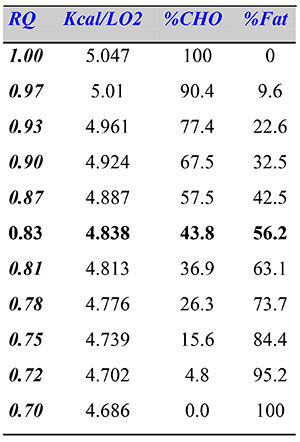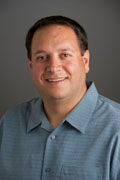
By Lance C. Dalleck, Ph.D., and Jeffrey M. Janot, Ph.D.
A myth can be defined as an untrue explanation for a natural phenomenon. Unfortunately, numerous myths remain pervasive and deeply engrained in the health and fitness world. In this second of a two-part series, we take a close look at five more longstanding myths to determine if they can withstand the weight of scientific scrutiny.
Myth #1: Lower-intensity exercise puts you in the fat-burning zone, so it’s preferable to higher-intensity exercise.
Our first myth involves the performance of low-intensity (<40% VO2max) exercise to burn greater amounts of fat. This myth has been perpetuated by many sources of health and fitness information, especially fitness-equipment guidelines. Look at the displays on the latest exercise equipment and you will likely see different “training zones” recommended for fitness and calorie burning. It’s not surprising this myth has lasted so long—after all, most people like the idea that lower-intensity exercise could actually be better for you than sweat-inducing higher intensities.
The metabolism of fat during exercise is a complicated process regulated by multiple hormones. To simplify, first understand that fat used for energy is drawn from two different sources: subcutaneous adipose tissue and intramuscular stores of triglycerides. Stored intramuscular triglycerides are the main source during moderate to higher intensities of exercise. In general, as exercise intensity increases, our usage of fat for energy peaks and then decreases. When does that peak occur—during lower or higher intensities of exercise? The myth and truth lie somewhere in between.
Much of the confusion regarding the optimal intensity to burn maximal fat comes from understanding and applying the non-protein caloric equivalents for RQ (respiratory quotient) chart (Figure 1). This chart details the amount of calories expended per liter of oxygen consumed at a given RQ. The RQ is calculated by dividing the amount of CO2 produced and O2 consumed at rest or during exercise. This value can then tell us the relative contributions of fat and carbohydrate to total energy expenditure.
Figure 1. Non-protein RQ Chart

For instance, at a RQ of 0.83, the percentage of total calories coming from fat and carbohydrate are 56.2% and 43.8%, respectively. As RQ increases or decreases from this value, the percentages change. Individuals who perpetuate this myth claim that this chart proves that low-intensity exercise (below RQ of 0.83) will burn more fat because the percent contribution from fat is higher. The problem is that total calories are lower at this intensity. Therefore, the total amount of fat burned is actually lower compared to higher intensities (greater total calories burned and thus more fat) for the same duration of exercise.
So, at what intensity does the “fat burning zone” occur? Researchers have identified where peak fat oxidation in the muscle occurs as a percentage of VO2max. Romijn and others (1993) showed this point as being equivalent to 65% VO2max with decreased oxidation at 85% VO2max. Achten and colleagues (2002) found a similar intensity to Romijn and discovered that maximum fat oxidation occurred within a range of 55 to 72% VO2max. Their data also showed that fat oxidation falls off quickly beyond intensities equivalent to 75% VO2max or greater.
According to past research, if we had to identify a “fat-burning zone,” it would occur at 65% or within the range of 55 to 72% VO2max. This is equivalent to moderate-vigorous exercise intensities. Additionally, to improve the muscles’ ability to oxidize fat at rest and during exercise, one must positively enhance mitochondrial density and function. This is best accomplished through interval training. Therefore, aerobic-program recommendations to augment caloric expenditure (and fat oxidation) during exercise would be to include a minimum of three days of moderate-intensity, longer-duration (45 to 60 minutes) workouts interspersed with one to two days of interval training. This combination program will provide opportunities for maximizing caloric expenditure (moderate intensity) and improving the metabolic function of the muscle (interval training) and overall fitness.
The Bottom Line: The “fat burning zone” at low intensities of exercise DOES NOT exist! The best approach is to think of energy expenditure as a calorie is a calorie is a calorie, rather than partitioning into carbohydrate and fat calories. To burn maximum calories in support of ongoing weight loss, progress to a moderate-intensity/higher-volume exercise program and include interval training.

Myth #2: Morning workouts increase metabolism better than workouts performed later in the day.
This myth has two components: (1) that exercise performed in the morning increases metabolism (a phenomenon known as excess post-exercise oxygen consumption or EPOC) that persists throughout the day and will subsequently result in more burned fat and ultimately lead to weight loss. And (2) that exercising on an empty stomach burns more fat compared to exercising after breakfast. Therefore, working out before breakfast will increase weight loss.
When a person stops exercising, their oxygen consumption (VO2) returns to baseline levels, first demonstrating an initial, fast or rapid component followed by a slow component (see Figure 2). In 1923, Hill and Lupton proposed that the elevated VO2 post-exercise was an oxygen debt. This interpretation was based on the understanding that there would be an oxygen cost involved with replenishing creatine phosphate and the oxidation of lactate produced from glycolysis during the oxygen deficit. More recently, it has been acknowledged that additional factors beyond those recognized by Hill and Lupton contribute to this elevated post-exercise metabolism. EPOC is believed to be the product of widespread homeostatic changes, and repayment of the oxygen deficit contributes only fractionally to this event. Accordingly, in 1984 the term EPOC was coined (Gaesser and Brooks, 1984) to better represent the multiple factors that contribute to elevated post-exercise metabolism.
Figure 2. Conceptual Schematic of Oxygen Deficit and Excess Post-exercise Oxygen Consumption (EPOC)

EPOC has two phases: rapid and slow. The duration of the rapid phase generally lasts two to three minutes, but may extend out toward 30 to 60 minutes, and primarily involves:
- Removal and reconversion (oxidation) of lactate
The slow phase may last 24 hours or longer, depending on the magnitude of tissue stimulation (repair and adaptation) and the amount of recovery needed, and includes:
- Continued thermoregulation
- Increased heart rate and ventilatory demand for anabolic processes
- Increased metabolism due to tissue repair and synthesis, and glycogen synthesis
- Residual effects of circulating sympathetic hormones (e.g., catecholamines)
- Removing an accumulated carbon dioxide remaining within body tissues
Exercise intensity and exercise duration contribute most notably to the magnitude of EPOC. Overall, it has been concluded that exercise intensity has a greater role in EPOC variability (~46% vs. ~9%) compared to exercise duration. Preliminary research findings increased interest in the possibility that EPOC could play an important role in weight loss.
Does excess post-exercise oxygen consumption (EPOC) play a significant role in weight loss?
Early researchers whose work focused on EPOC seemed to think this scenario might be a real possibility. However, more recent research since the seminal studies of the early twentieth century has cast some doubt on this likelihood. LaForgia and colleagues (2006) recently reviewed much of the research done on the topic of EPOC and concluded that the earlier optimism concerning a critical role for EPOC in weight loss is largely unsubstantiated.
The studies that have tended to elicit a substantial EPOC (e.g., >100 kcal) generally have consisted of regimens that are either high in intensity, long in duration, or both, raising concerns that there would be any effect in non-athletic populations. This particular issue can be underscored in a recent study by Knab and colleagues (2011), which required 10 male participants to complete two separate 24-hour visits (one exercise and one rest day) in a metabolic chamber. Careful energy balance was maintained for each visit. On the exercise day, participants cycled for 45 minutes at an intensity of 73% of maximal oxygen uptake (VO2max). The exercise bout itself resulted in an energy expenditure of 519 kcal. Energy expenditure remained elevated above resting levels for 14 hours postexercise, with the total EPOC reported to be an impressive 190 kcal. The authors concluded that the magnitude and duration of EPOC may have important implications for weight loss and management. However, it must be noted that the intensity of exercise performed by participants in this study was vigorous. For example, an exercise intensity of 70 to 75% VO2max generally corresponds to the lactate threshold level of an endurance-trained individual. Accordingly, it follows that individuals exercising to lose weight are probably unlikely to be capable of regularly performing the types of exercise workouts that research has found to be required for stimulating a meaningful EPOC.
In conclusion, it has been purported that the EPOC generates approximately 7% of the total energy expenditure of exercise. While the EPOC may be limited in the contribution it can make to most individuals in their weight-loss efforts, there may be a role for it in terms of energy balance (i.e., weight maintenance). It has been suggested that the cumulative effect of the EPOC over a one-year period may be the energy expenditure equivalent of 3 pounds of adipose tissue.
Does exercise before breakfast result in greater fat burning and weight loss?
A quick Google search reveals claims that exercise in the morning before breakfast will increase fat oxidation (i.e., fat burning) by threefold, compared to the magnitude of fat oxidation with exercise in the morning following a breakfast meal. While this would be ideal for those individuals with weight-loss or weight-management exercise goals, the scientific evidence clearly shows much more is needed to facilitate weight loss than simply exercising first thing in the morning before breakfast. It has been well-known for quite some time that the proportion of fat burned during an exercise session is higher when performed prior to eating (vs. after a meal). For example, Horowitz et al. (1997) demonstrated that during a one-hour session of moderate-intensity exercise, 40% of energy expenditure was from fat oxidation if the exerciser was in a fasting state. Exercising after consuming a carbohydrate breakfast resulted in just 20% of energy expenditure from fat oxidation. However, regardless of the sequence of exercise and meal (i.e., breakfast-exercise or exercise-breakfast) the overall energy expenditure from the exercise session was the same.
Research has clearly shown that total energy expenditure is equivalent across different meal and exercise orders (Farah and Gill, 2012; Horowitz et al., 1997); as such, any long-term weight loss attained would be comparable. Therefore, the decision to eat or not eat before exercise in the morning should be driven by personal preference rather than any false hopes that greater weight loss will be achieved by exercising before breakfast. Instead, consider urging clients who want to lose weight to simply extend their exercise sessions by 10 to 15 minutes each day to expend more calories.
The Bottom Line: Under ordinary circumstances, EPOC contributes minimally to overall energy expenditure. EPOC does not play a significant role in weight loss, nor is overall energy expenditure affected by exercising on an empty stomach.

Myth #3: Muscle weighs more than fat.
Your client mentions that, after weeks of hard work, she hasn’t lost weight, but strangely her clothes fit better. How would you respond? A common explanation is that lean body mass probably increased and muscle weighs more than fat; therefore, weight doesn’t change. Does this math add up?
Let’s answer that question by asking another question: Does a pound of fat and a pound of muscle weigh the same? The obvious answer is yes! The problem lies with equating the measurements “weight” and “density.” While weight (mass) is a component of density (mass/volume), they should not be used interchangeably. As we lose fat and gain muscle, weight may change very little, while body volume decreases as we become leaner. This causes density to increase. Is it also possible for an individual to have a high body-mass index (BMI) and low percent body fat? Check out Table 1.
Table 1. Body Weight vs. Body Composition
|
|
Height (feet)
|
Weight (lbs)
|
BMI
|
%Body Fat
|
|
Client 1
|
6’0”
|
220
|
30.2
|
10
|
|
Client 2
|
6’0”
|
220
|
30.2
|
25
|
Again, it would be wrong to say that the reason for a high BMI/low body-fat percentage is that muscle weighs more than fat. For Client 1, a higher amount of lean tissue and lower amount of fat equal the same weight as Client 2, but Client 1 is more dense/lean.
Considering the data in Table 1, the answer for your client may be that, while her weight is not changing, her body composition is, which could explain the better-fitting clothes. Increasing lean body mass while simultaneously losing fat will not make you weigh more, but your density will improve, undoubtedly a worthy goal.
The Bottom Line: Muscle DOES NOT weigh more than fat. For clients with weight-related goals, body composition measurement is likely the best way to evaluate the effects of their training programs.

Myth #4: Women who want to avoid looking bulky should avoid resistance training.
The misconception that resistance training will make women build large muscles has likely existed for as long as resistance training itself. The authors of this article have heard female clients of all ages regularly offer up the excuse: “I don’t lift weights because it will make me bulky or muscle-bound.” When asked why they believe this to be true, generally the response falls into one of two categories:
- They have viewed pictures of body builders or ‘ideal’ looking models in magazines.
- They have resistance trained in the past and felt their muscles were “tight,” which to them was synonymous with “bulky.”
Over the past few decades, research has clearly shown there are numerous health benefits for all individuals—men and women—who engage in regular resistance training. In fact, it has been shown that resistance training is vital for the prevention of sarcopenia (i.e., the loss of muscle mass that happens with aging), prevention of osteoporosis, prevention of low-back pain, improved balance, and increased ability to perform activities of daily living (Garber et al., 2011). Therefore, dispelling this myth has important health implications for women who are not performing resistance training because they are concerned they will look too bulky.
The central reason why most women will never look as big (i.e., bulky) as men is due to physiological differences. Research has consistently reported that women have less absolute muscle mass compared to men (Billaut and Bishop, 2009). A principal factor underpinning the muscle-mass disparity between sexes is differences in testosterone, which is a major promoter of muscular hypertrophy, strength and power. Levels of testosterone are typically 10 to 20 times higher in men compared to their female counterparts (Storey and Smith, 2012). Therefore, it is virtually impossible for women to undergo the same skeletal muscle adaptations to resistance training (i.e., increased muscle hypertrophy) as men.
While some women are certainly capable of achieving rapid and substantial increases in muscle mass, it is critical to help clients understand that rare instances of pronounced muscular hypertrophy are generally the product of good genetics, extreme nutrition (i.e., consuming diets very high in calories and protein) and exercise-training regimens (i.e., training several hours per day), and, in many cases, performance-enhancing drugs. These attributes differ markedly from many female clients, such as the middle-aged mom of two who, despite the great benefits she might achieve from performing as little as 30 minutes of resistance training two to three days per week, is afraid of gaining too much muscle.
Providing proper education for your female clients on the physiological endocrine and skeletal muscle differences between women and men, along with highlighting the numerous health benefits of regular resistance training, is the key to dispelling this myth.
The Bottom Line: Resistance training DOES NOT cause women to become bulky.

Myth #5: Spot reduction really works, especially if you want six-pack abs.
Performing hundreds of sit-ups or purchasing the latest core-training device to selectively lose inches around the midsection fuels this myth. At first glance, it may be surprising that this myth remains significantly entrenched in the health and fitness culture despite the countless articles proving it wrong. However, considering the multimillion-dollar industry supporting the infomercial “experts” selling this notion, it is no wonder why this myth stubbornly remains.
“Now you can get rock hard abs with no sweat!....Lose four inches in 30 days, guaranteed!....30% more effective at producing results than normal sit-ups!” You’ve undoubtedly heard claims like these before, but do they hold up against research? Katch and colleagues (1984) performed one of the earliest studies focused on addressing the theory of spot reduction. In this study, 13 males performed a vigorous abdominal program (equivalent to 5,000 sit-ups) over a period of 27 days. Measures of subcutaneous fat thickness via biopsy were taken pre- and post-program at the abdomen, buttocks and upper back. Results demonstrated that fat decreased similarly at all three sites, not just at the abdomen.<
Research shows that if a vigorous, high-volume,core-training program is performed, fat will be reduced in the abdominal area, but not selectively. The reduction of fat in the Katch study was more a function of increased energy expenditure. A lean midsection requires, then, a total program of core, resistance and aerobic exercise—not just a focus on the abdominal musculature. Therefore, looking past the six-pack, goals of core programs should be to improve the function of core stabilizers to enhance athletic and occupational performance and to improve low-back health.
The Bottom Line: Specific abdominal exercise cannot selectively remove inches from the abdominal area, no matter what the “experts” say!
References
Achten, J., Gleeson, M. and Jeukendrup, A. (2002). Determination of the exercise intensity that elicits maximal fat oxidation. Medicine & Science in Sports & Exercise, 34, 1, 92–97.
Billaut, F. and Bishop, D. (2009). Muscle fatigue in males and females during multiple-sprint exercise. Sports Medicine, 39, 4, 257–278.
Farah, N.M. and Gill, J.M. (2012). Effects of exercise before or after meal ingestion on fat balance and postprandial metabolism in overweight men. British Journal of Nutrition,, published online: October 26, 2012.
Gaesser, G.A. and Brooks, G.A. (1984). Metabolic basis of excess post-exercise oxygen consumption: A review. Medicine & Science in Sports & Exercise, 16, 1, 29–43.
Garber, C.E. et al. (2011). Quantity and quality of exercise for developing and maintaining cardiorespiratory, musculoskeletal, and neuromotor fitness in apparently healthy adults: Guidance for prescribing exercise. Medicine & Science in Sports & Exercise, 43, 7, 1334–1359.
Hill, A.V. and Lupton, H. (1923). Muscular exercise, lactic acid, and the supply and utilisation of oxygen. Quarterly Journal of Medicine, 16, 135–171.
Horowitz, J.F. et al. (1997). Lipolytic suppression following carbohydrate ingestion limits fax oxidation during exercise. American Journal of Physiology - Endocrinology and Metabolism, 273, E768
Katch, F. et al. (1984). Effects of sit-up exercise training on adipose cell size and adiposity. Research Quarterly Exercise and Sport, 55, 242–247.
Knab, A.M. et al. (2011). A 45-minute vigorous exercise bout increases metabolic rate for 14 hours. Medicine & Science in Sports & Exercise, 43, 9, 1643–1648.
LaForgia, J., Withers, R.T. and Gore, C.J. (2006). Effects of exercise intensity and duration on the excess post-exercise oxygen consumption. Journal of Sports Sciences, 24, 12, 1247–1264.
Romijn, J. et al. (1993). Regulation of endogenous fat and carbohydrate metabolism in relation to exercise intensity and duration. American Journal of Physiology, 265, 3, E380–E391.
Storey, A. and Smith, H.I. (2012). Unique aspects of competitive weightlifting: Performance, training and physiology. Sports Medicine, 42, 9, 769–790.
_____________________________________________________________________________
 Lance C. Dalleck, Ph.D., ACSM-RCEP, is academic coordinator of the Cardiac Rehabilitation postgraduate program at the University of Auckland in New Zealand. His research interests include improving exercise performance and health outcomes through evidence-based practice, quantifying the energy expenditure of outdoor and non-traditional types of physical activity, and studying historical perspectives in health, fitness and exercise physiology.
Lance C. Dalleck, Ph.D., ACSM-RCEP, is academic coordinator of the Cardiac Rehabilitation postgraduate program at the University of Auckland in New Zealand. His research interests include improving exercise performance and health outcomes through evidence-based practice, quantifying the energy expenditure of outdoor and non-traditional types of physical activity, and studying historical perspectives in health, fitness and exercise physiology.
 Jeffrey M. Janot, Ph.D., ACSM-CES, is an associate professor in Kinesiology at the University of Wisconsin−Eau Claire. His current research focuses on various aspects of sports physiology and strength and conditioning, cardiovascular physiology, and enhancing functional abilities of younger and older adults.
Jeffrey M. Janot, Ph.D., ACSM-CES, is an associate professor in Kinesiology at the University of Wisconsin−Eau Claire. His current research focuses on various aspects of sports physiology and strength and conditioning, cardiovascular physiology, and enhancing functional abilities of younger and older adults.